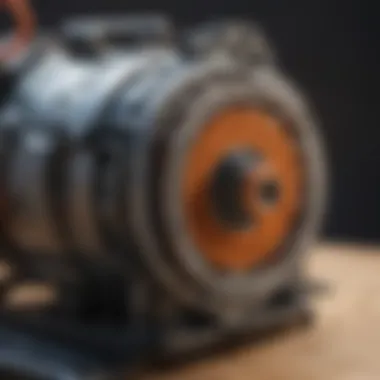Mastering Electric Chainsaw Maintenance and Repair


Intro
Electric chainsaws are vital tools for various tasks, from routine yard maintenance to significant logging activities. Understanding their mechanics is crucial for effective repairs and maintenance. Many users find themselves faced with challenges that can hinder performance or even result in complete failure of the tool. This article aims to provide a thorough understanding of how electric chainsaws work and how to address common issues.
Prologue to Electric Chainsaws
In the realm of power tools, electric chainsaws represent a pivotal advance in forestry and woodwork. They offer a combination of efficiency, lower noise levels, and reduced emissions compared to their gas-powered counterparts. Understanding their significance is essential not only for users but also for professionals who rely on these devices for their craft. The design of electric chainsaws has evolved, making them more user-friendly and suitable for various applications, from light pruning to heavy cutting tasks.
Historical Context
Electric chainsaws have a rich background that traces back to the early 20th century. Initially, chainsaws were bulky, gas-fueled machines that required significant physical strength and expertise to operate. The development of the electric chainsaw began in the 1960s, driven by the need for lighter, more manageable equipment. This transition reflected changes in technology and growing environmental awareness. Today’s electric chainsaws are products of many innovations, focusing on portability and ease of use. As technology advances, many brands have incorporated advanced safety features and ergonomic designs to meet the demands of modern users, further broadening their application in both commercial and residential settings.
Advantages of Electric Chainsaws
Electric chainsaws come with a multitude of advantages. First and foremost, they are generally easier to start than their gasoline counterparts. Users can simply plug them in or charge a battery, eliminating the hassle of fuel mixing and pull cords.
Additionally, electric chainsaws produce significantly less noise. This factor not only makes them more pleasant to use but also reduces the impact on the environment and surrounding wildlife.
Moreover, these chainsaws are often lighter and more compact, which enhances maneuverability. This is particularly beneficial for homeowners and professionals who may use the tool for extended periods.
Here are a few key advantages summarized:
- Ease of Use: Quick startup and user-friendly design.
- Reduced Noise: Operation at lower decibel levels.
- Portability: Light in weight and often equipped with ergonomic features.
- Environmentally Friendly: Lower emission of pollutants and reliance on renewable energy sources.
- Low Maintenance: Fewer mechanical issues compared to gas chainsaws, leading to lower repair frequency.
"Investing in an electric chainsaw can significantly enhance your efficiency while minimizing your ecological footprint."
Understanding these advantages helps users to make informed decisions when selecting chainsaws for their needs. It also prepares them for maintaining and possibly repairing the equipment over its lifetime.
Understanding Electric Chainsaw Mechanics
Understanding the mechanics of electric chainsaws is fundamental for effective repair and maintenance. An electric chainsaw has various components that work together, and each plays a pivotal role. Knowledge of these mechanics contributes significantly to troubleshooting problems. It enables users to identify issues accurately and perform repairs with confidence. This section delves into the key components of electric chainsaws, shedding light on their functionality.
Components Overview
Motor Types
The motor is the heart of an electric chainsaw. The two main types are brushed and brushless motors. Brushed motors are common due to their cost-effectiveness. They offer a simpler design and easier repairs, making them a popular choice for many users. In contrast, brushless motors are known for their efficiency and longer lifespan. They provide more torque and require less maintenance. Each type has distinct advantages:
- Brushed Motors:
- Brushless Motors:
- Cost-effective and readily available.
- Easier to repair as they have a simpler construction.
- Higher efficiency, resulting in longer battery life in cordless models.
- Less wear and tear, which leads to increased durability.
Having a clear understanding of motor types can significantly impact repair strategies and performance outcomes for the chainsaw.
Bar and Chain Assembly
The bar and chain assembly is crucial for the cutting function of the chainsaw. The bar is a metal plate that provides the guide for the chain, while the chain consists of interconnected metal links. A key characteristic of the bar is its length, which affects cutting capacity. A longer bar allows for deeper cuts, making it suitable for larger jobs.
- Characteristics of Bar and Chain Assembly:
- The length of the bar usually ranges from 10 to 20 inches, depending on the use.
- Chain types can vary by pitch and gauge, impacting cutting efficiency and safety.
Users must choose the appropriate bar and chain assembly for their specific tasks. A mismatch can lead to inefficient cuts or increased strain on the motor.


Electrical System
The electrical system of an electric chainsaw includes the power source, wiring, and switches. This system is vital as it powers the motor and ensures its smooth operation. A crucial characteristic is its voltage rating, which influences the chainsaw's cutting power and speed. For example, a 120V chainsaw is suitable for most residential tasks, while a 240V model might be necessary for more demanding applications.
- Benefits of Understanding the Electrical System:
- Users can identify faults in the wiring more easily.
- Knowledge of voltage requirements aids in selecting compatible power sources, enhancing overall functionality.
Each component in the electrical system has its unique features and possible failure points. Recognizing these can streamline troubleshooting and repair processes.
How it Works
Understanding how an electric chainsaw operates is essential for effective repairs and maintenance. The process begins when the user activates the power switch. The electrical current flows to the motor, generating rotational energy. This energy then drives the bar and chain assembly. As the chain moves along the bar, it engages with the material being cut. Utilizing a proper technique ensures efficiency while minimizing potential damage to the saw.
In summary, recognizing the function and interaction of the chainsaw's components is imperative. Proper knowledge transforms potential repair challenges into manageable tasks.
Common Issues in Electric Chainsaws
Understanding common issues in electric chainsaws is crucial for effective maintenance and repair. By identifying these problems, users can prolong the lifespan of their tools and ensure they operate efficiently. Knowing the potential failures helps in troubleshooting effectively, thereby minimizing downtime during work. Also, recognizing these issues early can prevent larger, costly repairs down the line.
Electrical Failures
Electrical failures are among the most frequent issues encountered in electric chainsaws. These failures can stem from several factors such as worn-out wiring, poor connections, or failed components like the motor or switch. Common symptoms include the chainsaw not starting or functioning intermittently. Users must check the power source first to eliminate simple fixes, such as faulty extension cords.
If these are ruled out, inspecting the internal electrical parts is essential. This involves checking the integrity of wires and the output of switches using a multimeter. Uncovering these issues early allows for timely intervention, thereby maintaining performance and efficiency.
Mechanical Failures
Mechanical failures in electric chainsaws can significantly impede their performance. Issues such as malfunctioning motors, wear and tear of gears, or problems with the chain tensioning system can arise from usage or lack of maintenance. Symptoms typically include unusual noises during operation or a complete failure to cut.
Routine maintenance helps in preventing these mechanical issues. For instance, keeping the chain well-lubricated reduces friction and wear on components. Moreover, if problems occur, a thorough inspection of the internal parts is necessary. Checking the motor and ensuring components align properly can save time and effort in repairs.
Chain and Bar Problems
Chain and bar problems are a common hindrance to the effective performance of electric chainsaws. The chain may become dull or lose tension through extensive use, affecting its cutting ability. A worn-out bar can also lead to inaccuracies during cutting tasks. Users should be aware of the signs of wear, such as a reduced ability to cut through wood and an increase in kickback incidents.
Regular inspection of the chain tension and sharpness can mitigate these problems. It is also advisable for users to familiarize themselves with the adjustment mechanisms for optimal performance. When necessary, the chain should be replaced according to the manufacturer’s guidelines, and the bar should be inspected for damage frequently.
"Routine inspections and addressing common issues can greatly enhance the performance and lifespan of your electric chainsaw."
Diagnostic Steps for Electric Chainsaw Repair
Repairing an electric chainsaw involves systematic diagnostic steps. This process is crucial for a few reasons. First, thorough diagnostics help accurately identify the root cause of the problem. This can save time and prevent unnecessary purchases of replacement parts. Second, understanding the issues allows for targeted repairs which enhance the overall lifespan of the equipment. Lastly, a good grasp of the diagnostic process improves the user’s confidence in handling future chainsaw troubles.
Initial Observations
When troubleshooting an electric chainsaw, initial observations are essential. Observing the tool's performance can provide invaluable clues. For example, noticing if the chainsaw is hard to start, produces strange noises, or shows sparks can indicate specific issues. A user should inspect the power source, ensuring it is correctly plugged and functional. This stage includes checking for any visible damage, such as cracks in the housing or frayed cables. Taking note of these initial details can significantly direct the repair process, guiding the user to focus on certain areas first.
Testing for Electrical Issues
Electrical problems are common in electric chainsaws. To find these problems, some testing methods are effective.
Multimeter Use
Using a multimeter is vital for diagnosing various electrical issues. A multimeter can measure voltage, current, and resistance. Its versatility makes it a beneficial tool for electric chainsaw repairs. The key characteristic of the multimeter is its ability to provide real-time readings. This feature allows users to determine if a component is functioning properly. Furthermore, multimeters are straightforward to use, which adds to their appeal. However, one disadvantage is the need for some basic understanding of electrical systems to interpret the results correctly.
Circuit Continuity Testing


Circuit continuity testing is another important process in diagnosing electric chainsaw issues. This method checks if the electrical flow is uninterrupted. By using a multimeter in continuity mode, users can identify breaks in the circuit. This is a beneficial technique since it directly points to issues rather than making assumptions. The primary advantage of circuit continuity testing is its straightforward approach to pinpointing faults in the wiring. However, it also requires an understanding of the circuit layout, which could be a challenge for some users.
Inspecting Mechanical Components
After addressing electrical aspects, inspecting mechanical components is crucial. Mechanical issues can also create significant problems in chainsaw performance. This inspection includes checking the motor, bar, and chain. Users should look for signs of wear, such as scratched areas, which can indicate problems. Misalignment of parts can also affect overall functionality. A thorough examination ensures that any mechanical problems are identified and remedied before they escalate into more severe issues. By taking time to inspect these components carefully, users can maintain optimal chainsaw performance.
Repairing Electrical Failures
Repairing electrical failures in electric chainsaws is critical for proper functionality and longevity of the tool. These failures often stem from issues in the electrical components, which can hinder performance, compromise safety, or render the tool completely unusable. Understanding how to identify and resolve these failures not only enhances one's proficiency in maintaining electric chainsaws but also contributes to a safer working environment. Given the reliance on electricity in these tools, addressing electrical failures can mitigate risks associated with potential malfunctions.
Identifying and Replacing Faulty Components
To effectively repair electrical failures, it is essential first to identify faulty components within the chainsaw. Common electrical failures include issues with the motor, wiring, and switches. Signs of failure might manifest as inconsistent power, strange noises during operation, or, in severe cases, a total lack of power.
- Motor: Inspect the motor for burnt smells or discoloration. These symptoms indicate overheating or electrical short circuits.
- Wiring: Check for frayed wires or loose connections. Damaged wiring can lead to shorts or inconsistent power supply. A continuity test with a multimeter can assist in diagnosing breaks in the wiring.
- Switch: Malfunctions in the switch prevent the tool from turning on. Testing switches with a multimeter can confirm if they are functioning correctly.
Once the faulty component is identified, replacement involves sourcing the correct part. It is essential to choose components that are specifically designed for the brand and model of the chainsaw to ensure compatibility.
Soldering Techniques
Soldering is a crucial skill when repairing electrical components. Good soldering ensures strong, reliable connections which are vital for the efficiency of electric chainsaws.
- Preparation: Start by cleaning both surfaces that are to be joined. Use a fine sandpaper or a file to remove any oxidation.
- Heating: A soldering iron with suitable wattage is important. Too hot, and it can damage components; too cold, and it cannot melt the solder.
- Soldering Process: Apply the solder to the joint, not directly to the iron. This allows the heat to transfer to the joint and ensures a clean, effective bond.
- Cooling and Testing: Allow the solder to cool without disturbing it. Once cooled, test the repair's strength by gently tugging on the wires.
Following these steps in repairing electrical failures will not only improve the functionality of electric chainsaws but also extend their lifespan. A methodical approach ensures safety and efficiency, allowing for successful repairs.
Repairing Mechanical Failures
Repairing mechanical failures in electric chainsaws is a crucial aspect of their overall maintenance. These mechanical components are integral to the functioning of the chainsaw. If they fail, the chainsaw may not operate effectively, leading to inefficiency and increased risk of injury. By focusing on repairing the mechanical failures, operators can extend the lifespan of their tools and ensure they perform safely and efficiently.
Understanding the components that may require repair is essential. This includes the chain, bar, and motor. Each of these parts plays a distinctive role in the operation of the chainsaw. For instance, a damaged chain can not only hinder performance but also pose safety risks. Hence, timely repairs are necessary to mitigate these risks and enhance the efficiency of the equipment.
Replacing the Chain and Bar
Chain and bar replacement is among the most common mechanical repairs for electric chainsaws. Chains can become dull, stretch, or even break after extended use. A worn-out chain can lead to reduced cutting efficiency, causing the saw to bind or kick back during operation. Similarly, the guide bar can wear down, leading to improper chain alignment.
To replace the chain and bar:
- Unplug the Chainsaw: Always ensure the chainsaw is disconnected from the power source to avoid accidental activation.
- Remove the Side Cover: Most electric chainsaws have a side cover that must be removed to access the chain and bar.
- Detach the Old Chain: Take off the old chain by loosening it from the bar. Carefully inspect the bar for any signs of wear or damage.
- Install the New Chain: Place the new chain onto the bar, ensuring it's oriented correctly. The teeth should face in the direction of the rotation.
- Reattach the Bar and Side Cover: Securely fasten the bar and side cover back to the chainsaw. Adjust the tension of the chain according to the manufacturer’s specifications.
Following these steps ensures that the chainsaw will perform effectively, and minimizes potential hazards during use.
Motor Maintenance and Replacement
The motor is the heart of an electric chainsaw. Proper maintenance can extend its life and ensure optimal performance. Signs of motor failure include unusual noises, loss of power, or overheating. Regular maintenance practices can help to identify issues before they escalate.
For maintaining the motor:
- Keep it Clean: Regularly clean the motor housing to prevent dust and debris from accumulating, which can affect performance.
- Check for Wear: Inspect electrical connections and components for signs of wear or loose wires.
- Lubrication: If applicable, lubricate moving parts according to the manufacturer's instructions to prevent friction and overheating.
If the motor fails, replacing it is a complex task that may require professional assistance. The replacement generally involves disassembling the chainsaw, removing the old motor, and installing a new one. Ensure that the replacement motor is compatible with the specific model of chainsaw.
Inadequate attention to mechanical repairs can lead to chronic issues and potentially unsafe conditions during operation.
Safety Considerations During Repair
When it comes to repairing electric chainsaws, safety cannot be underestimated. Working with tools that operate at high power introduces several risks to the user. Adhering to steadfast safety practices not only protects the individual but also ensures a successful repair process without further damaging the equipment. Missteps or neglecting safety protocols can lead to injuries or ineffective repairs, causing more issues later on. Prioritizing safety is vital to fostering a responsible attitude towards tool maintenance.


General Safety Tips
- Read the Manual: Before starting any repairs, carefully read the chainsaw’s user manual. Understanding the device's specifications and limitations is key to safe usage.
- Wear Protective Gear: Always wear appropriate personal protective equipment (PPE) such as safety glasses, gloves, and sturdy footwear to minimize the risk of injury.
- Work in a Safe Environment: Choose a well-lit, clean workspace free from distractions and hazards. A tidy area ensures clear access to your tools and prevents accidents.
- Disconnect Power: Before beginning any repair, ensure the chainsaw is unplugged or the battery is removed. This precaution eliminates electrical hazards during maintenance tasks.
- Handle Tools with Care: Use tools and equipment as intended. Avoid using makeshift tools that can increase the chance of accidents.
Proper Use of Tools
The effective function of repair necessitates using the right tools. Each tool has its specific purpose and employing them correctly is paramount.
- Multimeter: Essential for diagnosing electrical issues. Familiarize yourself with its functions and settings for accurate readings.
- Wrenches and Screwdrivers: Use the correct size to avoid stripping screws and bolts. Improper use can lead to damage and increase repair difficulty.
- Soldering Iron: When dealing with faulty wiring or components, ensure proper technique is employed to avoid overheating or damaging the circuit.
- Safety Knife: For removing old wiring insulation, use a safety knife to prevent personal injuries.
Proper tool use greatly enhances repair outcomes and safety.
Implementing these best practices enhances individual safety and improves the repair process, resulting in a more efficient and effective resolution to any chainsaw issue.
Preventive Maintenance Techniques
Preventive maintenance is an essential aspect of electric chainsaw upkeep, ensuring its efficiency and longevity. By implementing regular maintenance practices, users can avoid unexpected failures and costly repairs. This not only enhances performance but also promotes safe operation. Investing time in preventive maintenance reduces the likelihood of significant breakdowns, ultimately saving both time and money.
Regular Inspection Protocols
Conducting regular inspections is critical for maintaining an electric chainsaw. These inspections should focus on key areas such as the motor, bar, chain, and electrical components. Carefully examine the chain for wear and tension, ensuring it is adjusted according to manufacturer specifications. Check the bar for any signs of damage, such as bending or excessive wear. The motor should also be assessed for any unusual sounds or vibrations that may indicate problems.
Additionally, inspect the electrical cords and connections for any fraying or loose components. Look for discoloration or signs of overheating in the wiring. If any issues are identified during the inspection, they should be addressed immediately to prevent further damage.
Here is a basic checklist for inspections:
- Ensure the chain is sharp and properly tensioned.
- Check the oil reservoir and refill if needed.
- Look for cracks or damage in the bar.
- Inspect the motor for irregular sounds.
- Verify that all electrical connections are secure.
Storage and Handling Practices
Proper storage and handling of electric chainsaws play a crucial role in their maintenance. After each use, chainsaws should be cleaned to remove debris and sap, which can cause corrosion over time. Store the chainsaw in a dry place to avoid moisture buildup, which can damage electrical components.
When handling the chainsaw, always use protective gear, such as gloves and safety glasses. This reduces the risk of injury and ensures safe operation.
In addition, if the chainsaw is not in use for an extended period, consider removing the chain and applying a light coat of oil to protect it from rust. Proper care during storage can significantly extend the lifespan of chainsaws.
"Regular maintenance can prevent up to 80% of repairs needed for electric chainsaws."
Ultimately, understanding and implementing preventive maintenance techniques can lead to optimal performance of electric chainsaws. It keeps the equipment in peak condition while ensuring safe operation for the user.
Epilogue
The conclusion of an article serves as a vital component to reinforce the insights discussed throughout the text. In the context of electric chainsaw repair, it emphasizes the necessary steps for effective maintenance, addressing common repair issues, and providing clear guidance for safe handling. By summarizing the key points, readers gain clarity and understanding, which can lead to more effective decision-making when faced with electric chainsaw difficulties.
One significant element of the conclusion is the emphasis it places on preventive maintenance practices. Regular inspection and proper care can prolong the life of chainsaws. Readers are reminded that a proactive approach is more sustainable and cost-effective than waiting for complete failures.
In addition, the conclusion allows for reflection on the evolving technology of electric chainsaws. It raises awareness about the implications of advancements in motor efficiency and battery technology, and how these changes may influence repair and maintenance needs.
Ultimately, a well-articulated conclusion connects the dots for the reader, ensuring that key insights are retained and actionable. This clarity can enhance both the performance of the user’s equipment and their overall understanding of electric chainsaw dynamics.
Summarizing Key Points
- Understanding Mechanics: Gaining insight into the different components of electric chainsaws enhances troubleshooting.
- Common Issues: Awareness of electrical and mechanical failures enables users to identify problems earlier.
- Effective Diagnostic Steps: Following systematic approaches assists in diagnosing and rectifying issues swiftly.
- User Empowerment: Knowledge of repair and preventive techniques allows users to maintain their tools confidently, ensuring optimum performance.
While each of these points is essential on its own, their integration empowers the user to tackle future challenges effectively.
Future of Electric Chainsaw Technology
The future of electric chainsaw technology is an avenue of great potential. As manufacturers focus on innovative designs and improved efficiency, users must remain informed about these advancements.
- Battery Technology Improvements: Expect enhancements in battery life and charging capabilities. This can lead to longer periods of use between charges, increasing overall efficiency.
- Smart Features: There is a movement toward smart technologies that introduce diagnostics directly into the tools. Features such as real-time monitoring and maintenance alerts will become commonplace, simplifying the repair process.
- Environmental Considerations: As sustainability becomes an integral part of tool design, manufacturers are likely to develop more eco-friendly electric chainsaws. This shift will not only benefit the environment but may also reduce noise and emissions during use.
- Modular Designs: Future chainsaws may adopt modular designs that allow for easier repairs and customization. Users may be able to swap out parts without technical expertise, simplifying maintenance.
Understanding these trends can facilitate proactive adjustments in personal maintenance practices and open avenues for professional growth in the forestry sector.



